Today begins our journey through ancient Arabian skies. We’re starting now because the movements of the celestial Well Bucket tell us that a new year is approaching, and with it the long-awaited “marking” rains of autumn.
Two star calendars will guide us in this new year. One is a calendar of rain stars (anwa’) shared by the Arab tribes of Qushayr and Qays. The other is an early calendar of the lunar stations (manazil al-qamar). Although these calendars are very different, they both begin and end their years with the celestial Well Bucket (ad-dalw).
في خريف سقاه نوء من الدلو تدلى ولم توار العراقي
During the autumnal season of fruit harvest,
stars from the Well Bucket sent to him rain
while they hung down low in the sky,
the Crossbars not yet concealed.‘Adi bin Zayd,
6th century C.E.
For many tribes of Arabia, the year consisted of six seasons of varying length. The last of these was called kharif because it was the time when people harvested (kharafa) dates and other kinds of fruit. The first rains to follow the drought of summer fell during kharif, but the new year began with the onset of the autumnal rainy season called wasmi. This season was so named because its rains literally marked (wasama) the earth with the intensity of their falling, and because the vegetation that quickly followed would rapidly mark the desert in vibrant shades of green.
How to observe the Well Bucket
It is fitting that, in the transition from the lighter rains of kharif to the marking wasmi rains of the new year, many of the Arabs saw a magnificent stellar Well Bucket pouring out water onto the earth.

The Well Bucket (ad-dalw) and its elements as they appear setting in the west about 45 minutes before sunrise in early October. Sky simulations made with Stellarium.
The proper time to observe a star’s morning setting (or rising) is called ghalas in Arabic, at time when the darkness of night mixes with the white and red light of dawn in the tracts of the horizon (How to Observe). Because right now there is a bright moon nearby, I’d recommend being ready to observe this week 60 minutes before your local sunrise (times available at timeanddate.com). Look to the western horizon. There, you will see a large, near-perfect square of four bright stars, resting one of its corners right on the horizon. This is the celestial Well Bucket (ad-dalw, pronounced “a-DEL-oo”), which has been known among the Arabs since the 6th century CE, as ‘Adi b. Zayd’s poem above attests.
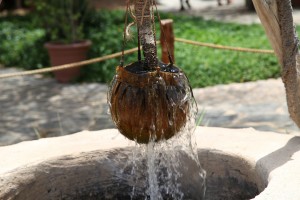
A modern leather well bucket from UAE.
“Leather bucket of a well” by Neogeolegend – Own work. Licensed under CC BY-SA 3.0 via Commons.
In those times–and sometimes still today–well buckets were fashioned from flexible camel leather. Two wooden crossbars intersected at the top of the bucket, forming the leather brim into the shape of a square. These crossbars were tied together tightly with rope to prevent the bucket’s mouth from collapsing when it was submerged into the water. The main well rope then connected the crossbars to the structure of the well. All of these features of the leather well bucket were delineated in its celestial counterpart, ad-dalw.
In describing the four primary stars of the Well Bucket, the “front” (muqadam ad-dalw) refers to the two stars that rise and set first (the western side of the Well Bucket), and the “rear” (mu’akhar ad-dalw) consists of the other two stars that follow.
The Crossbars of the Bucket as rain stars
For a brief description of the rain stars, please see the Celestial Complexes section on the About page.
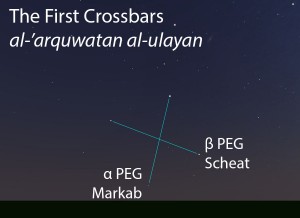
The First Crossbars (al-‘arquwatan al-ulayan) as they appear setting in the west about 45 minutes before sunrise in early October.
The line of poetry from ‘Adi bin Zayd above shows that the four bright stars of the Well Bucket were also called the Crossbars (al-‘araqi) in the 6th century. The rain star calendar shared by the Arab tribes of Qushayr and Qays was recorded much later by both Qutrub (died 821 CE) and Abu Zayd al-Ansari (died 830 CE). Designed to forecast seasons of rain, the calendar began in late September with the coming of the wasmi rains and the pre-dawn setting of the Rear Two Crossbars of the Bucket (al-‘arquwatan al-mu’akharatan min ad-dalw). A star’s setting occurred when it was obscured by the light of dawn (during galas) just as it approached the horizon. The calendar ended with the pre-dawn setting of the First Two Crossbars of the Bucket (‘arquwata ad-dalw al-ulayan) in mid-September of the following year. No two of the four Crossbar stars set at the same time, so only six days separated the setting of the second First Crossbar star (Scheat in the map above) and the setting of the first Rear Crossbar star (Algenib in the star map).
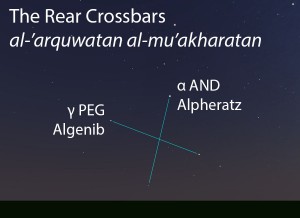
The Rear Crossbars (al-‘arquwatan al-mu’akharatan) as they appear in the west about 45 minutes before sunrise in early October.
How many crossbars do you see? Like English, Arabic has grammatical forms for singular and plural things, but also a special form for two things, called the dual. Although used less frequently in modern times, the dual is especially common in old star names. The well bucket used two pieces of wood as crossbars, but in the sky each star was seen as the endpoint of a crossbar piece that started at the center, where the four were tied together by the Crossbar Rope (al-karab). The two stars that represent the Crossbar Rope do not appear in the literature until the time of ‘Abd ar-Rahman as-Sufi, known to Europe as Azophi (died 986 CE). This demonstrates the difficulties of dating these star names, a scenario that will be repeated many times throughout our journey.
In addition to the Crossbar Rope, some Arabs identified a bright orange star near the Rear Crossbars as the Well Rope (ar-risha’) that connects the Well Bucket to the well. Further details about this name have not withstood the ravages of time, but it is plausible that the Well Rope included not only this bright star, but also one or two chains of dimmer stars that lead from the Rear Crossbars to points beyond the bright orange star. (See the Well Rope page for more on this.)
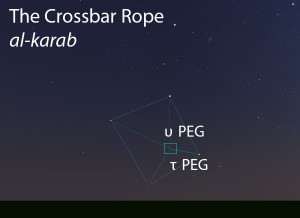
The Crossbar Rope (al-karab) as it appears in the west about 45 minutes before sunrise in early October.
In the writings of Ibn Qutayba (died 889 CE), the First Crossbars are also called the Higher Crossbar (al-‘arquwa al-‘ulya), and the Rear Crossbars the Lower Crossbar (al-‘arquwa as-sufla). This orientation is observable only when the Crossbars are rising in the east, so those of you who cannot observe the Crossbars at 5am can experience their “upright” orientation in the early evening hours. The use of the singular word “crossbar” in the names above more accurately represents the mechanical construction of a well bucket with two solid crossbar pieces. However, it does not reflect the reality of the crossbar correlates in the sky, which rise as pairs of adjacent stars rather than opposing stars. This usage may reflect an adaptation of the Crossbars to be consistent with the Two Spouts (al-farghan, see below).
The Spouts of the Bucket as lunar stations
For a brief description of the lunar stations, please see the Celestial Complexes section on the About page.
Once you have the crossbars in place at the top of a leather well bucket, you can pour water from between any two crossbar segments. In the sky, the empty space between each two adjacent stars of the square forms a Spout (fargh). Thus, the First Crossbars were also the First Spout (al-fargh al-awal) or the Front Spout (al-fargh al-muqadam). The Rear Crossbars were the Second Spout (al-fargh ath-thani), also known as the Last Spout (al-fargh al-akhir) or the Rear Spout (al-fargh al-mu’akhar). Together, these two pairs of stars were called the Two Spouts (al-farghan). Within the celestial complex of the lunar stations, these stars are always known as Spouts and never as Crossbars.
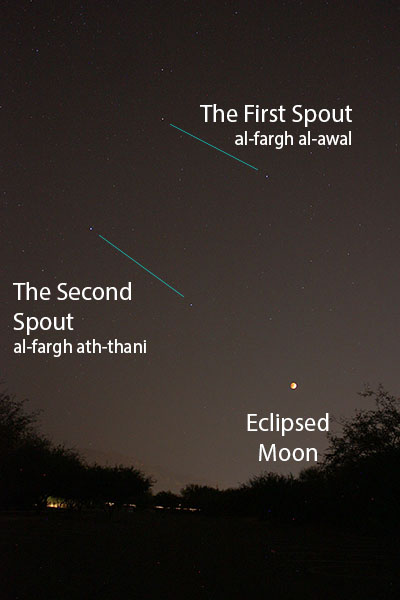
Wide-field view of totality during the September 27, 2015, total lunar eclipse. View looks east and includes the Well Bucket (ad-dalw) and its Two Spouts (al-farghan).
Adapted from the Hindu nakhshatras, the Arab lunar stations number 28 star groupings or single stars spread along the path that the moon takes across the sky. If you watched the total lunar eclipse on Saturday, you witnessed the moon stationing (resting or stopping) at the Second Spout. On the night before, the moon’s position was further west in the sky, and on that night it rested near the First Spout. This happens because the moon is orbiting around the earth, so each night we see it, its position has changed with respect to the stars.
Qutrub’s account of the lunar stations is a brief listing of the station names and their order. There, the calendar of the lunar stations begins with the pre-dawn setting of the Second Spout (the 1st station) and ends with the pre-dawn setting of the First Spout (the 28th station) almost a year later. This is exactly consistent with the endpoints of the Arab rain star calendar.
In the account of Ibn Qutayba (d. 889), we see a very refined exposition of the lunar stations and a new order of their presentation. Here, the order of the lunar stations matches the order of the Hindu nakhshatras, which starts with ash-sharatan in modern-day Aries. All mentions of the lunar stations from this time on begin with ash-sharatan and not al-fargh ath-thani. This change shifted each of the lunar stations backward by two stations, so that the First Spout became the 26th lunar station, and the Second Spout the 27th one.
Well Bucket stars amidst the Greek constellations
If you are familiar with astronomy, you may have realized by now that the Arab Well Bucket is the same star grouping as the Great Square of Pegasus. Why didn’t we begin with Pegasus? The goal of this blog and its website is to present Arab stars within their own cultural contexts. In this way, our view of Arabian skies will be less fractured by whatever star knowledge we already possess.
As far as Pegasus goes, when Greek astronomical texts were translated into Arabic, the stars of the Well Bucket (ad-dalw) became part of the Greek constellation as al-faras al-a’zam, the Greatest Horse. Today’s modern star names for the bright stars of Pegasus derive largely from the Arabic descriptions of the winged horse. For example, Alpheratz, the name for the star shared by both Pegasus and Andromeda (α AND/δ PEG) literally means “the horse” (al-faras).
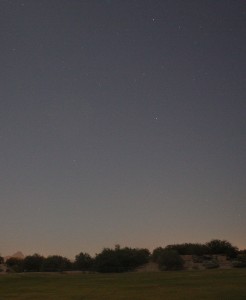
The Well Bucket as observed from Tucson, Arizona, at 5:25am (54 minutes before sunrise) on Oct 1, 2015. The first Crossbar star has just disappeared behind the trees.
What happened to the Well Bucket? Those of you who speak Arabic may be feeling confused after reading this blog post because you associate ad-dalw, the Bucket, with the constellation Aquarius. As one of the constellations of the zodiac, the figure of Aquarius came to Arabia well before Pegasus did. In translating the zodiacal constellation names into Arabic, the existing name ad-dalw was reused to designate the figure of Aquarius, the one who pours water out of a bucket. For a time, the same name was used for both star groupings (the Well Bucket and the zodiacal figure of Aquarius). After the stars of the Well Bucket became associated with the constellation of Pegasus, Aquarius gradually became the primary referent for the name ad-dalw. Today, few people are aware of the legacy of this ancient name.
Don’t let the great celestial Well Bucket run dry! Tell your friends about its “marking” rains using the links at the top of this page.
What’s next?
Our journey through Arabian star calendars has begun with the Well Bucket at the start of an Arabian New Year. In two weeks, we will attempt to trace the figure of an ancient celestial fish.
In the meantime, I’d love to hear from you! Did you find the Well Bucket and its parts? On which days did the stars of the First Crossbars (First Spout) set during the galas of the morning, from your location? How about the Rear Crossbars (Second Spout)?
Please leave a comment below, and be sure to include your city and state/country so we can see how the setting times vary by location.
Star Catalog Entries for this Celestial Complex
The Well Bucket Complex (ad-dalw, الدلو)
The First Crossbars (‘arquwata ad-dalw al-ulayan, عرقوتا الدلو الأليان)
The Rear Crossbars (al-‘arquwatan al-mu’akharatan min ad-dalw, العرقوتان المؤخرتان من الدلو)
The Crossbar Rope (al-karab, الكرب)
The First Spout (al-fargh al-awal, الفرغ الأول)
The Second Spout (al-fargh ath-thani, الفرغ الثاني)
The Well Rope (ar-risha’, الرشاء)
Click here to go to the full star catalog (a work in progress).

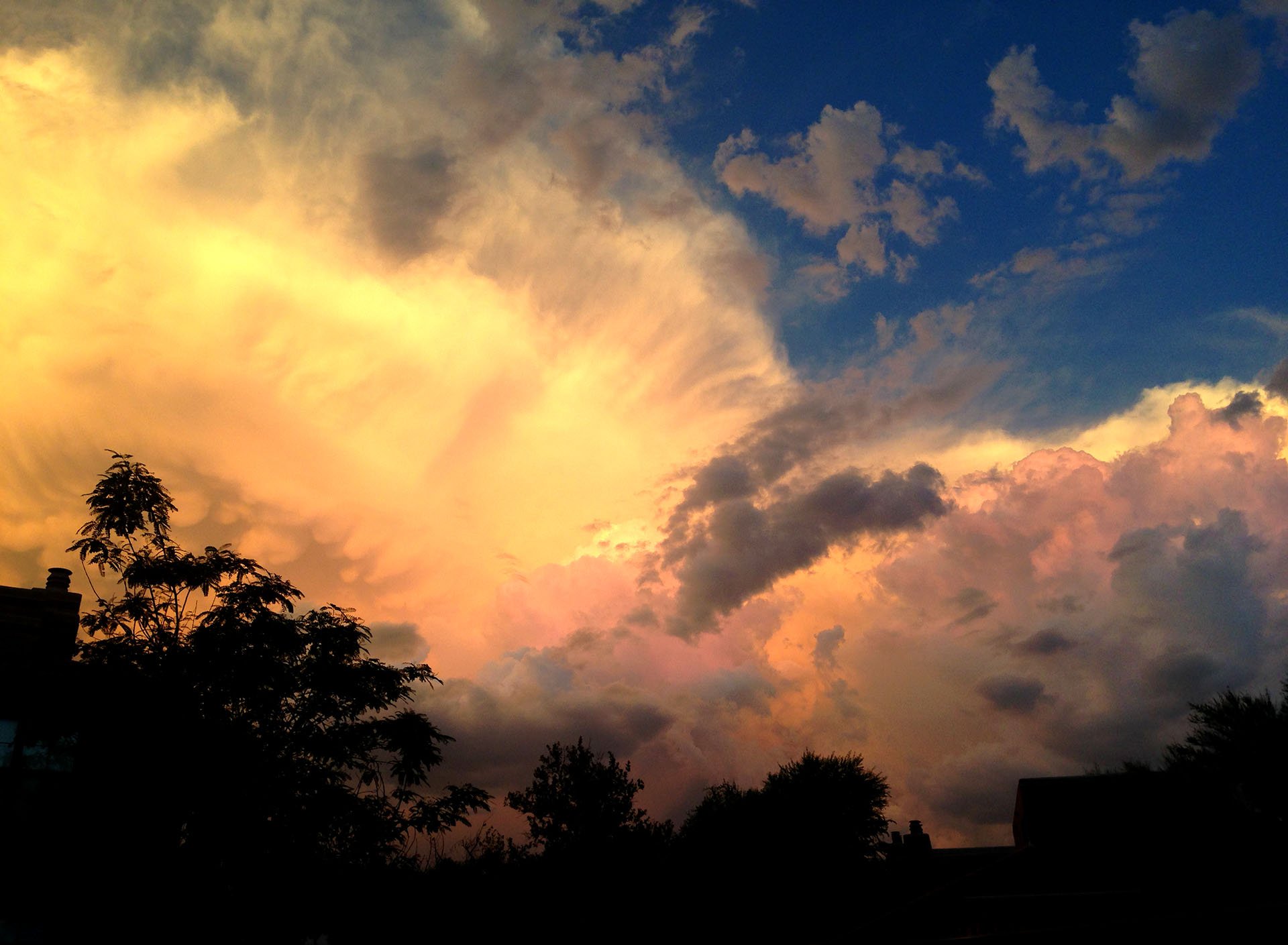
Great Job Danielle! Wow!! Keep it up~You are such an amazingly connected brillant mind! Sending you my Best Wishes! ✨?✨